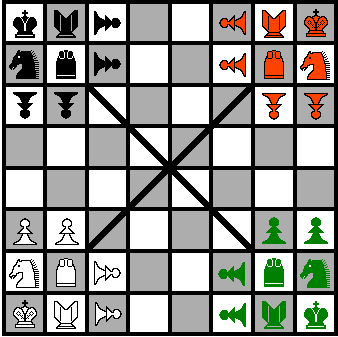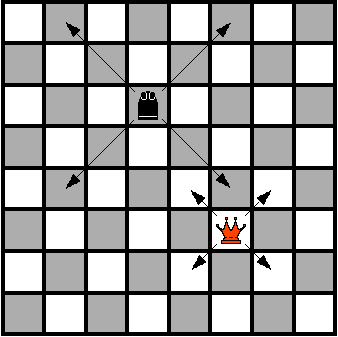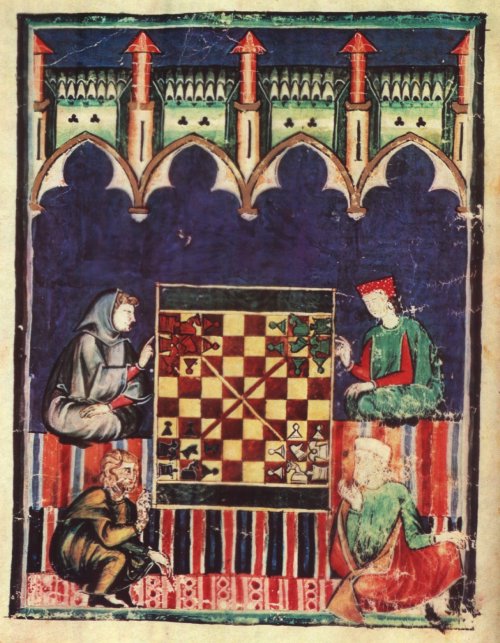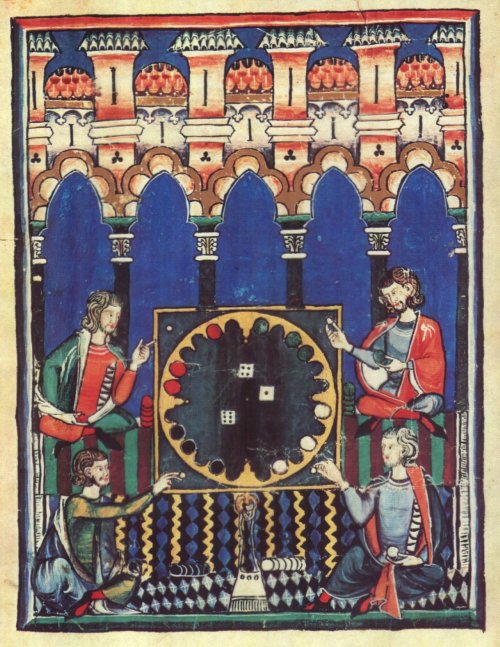Four Seasons Chess
In the Spanish codex of Alfonso X(1283), there was also a Four Handed Chess. It differs from Indian Chaturaji because here each player plays for himself, against three opponents. There is no team play. However, it is very plausible that this four player variant was again inspired by some oriental influence as al-Bīrūnī had described Chaturaji in 1030.
The symbolism attached to this game was very strong. Every side was associated to a color, a season (hence the name of Acedrex de los Quatro Tiempos), an element and a "humor". In the Middle Age, people were thinking that humors were due to fluids flowing inside the human body.
|
Color |
Season |
Element |
Humor |
|
Green |
Spring |
Air |
Blood |
|
Red |
Summer |
Fire |
Choler |
|
Black |
Autumn |
Earth |
Melancholy |
|
White |
Winter |
Water |
Phlegm |
folio 88v
DESCRIPTION:
This game makes use of a regular 64 squares Chess board. The two diagonals which stand on the illustration play no role in the game, there are just a visual aid for the Pawn's move. Pieces are placed at the corner (a difference with the Indian Chaturaji) allowing frontal clashes between the players.

Every side has: 1 ![]() King (Rey), 1
King (Rey), 1 ![]() Elephant (Alffil), 1
Elephant (Alffil), 1 ![]() Horse (Cavallo), 1
Horse (Cavallo), 1 ![]() Rook (Roque) and 4
Rook (Roque) and 4 ![]() Pawns (Peon). Note that Green and
Black have their Horse at right hand whereas White and Red
have it at left.
Pawns (Peon). Note that Green and
Black have their Horse at right hand whereas White and Red
have it at left.
RULES:
Green starts, which is logical for
Spring. Then, players play in the order of the
seasons.Pieces move according to mediaeval rules. The
Elephant jumps at the 2nd square, diagonally. The Pawn
moves 1 step straight forehead and get promoted into a ![]() Queen (Alfferza), a piece which is
not represented on the starting array. Then, it moves 1
step diagonally in all 4 directions.
Queen (Alfferza), a piece which is
not represented on the starting array. Then, it moves 1
step diagonally in all 4 directions.

Moves of Alffil and Alfferza
When a player mates another King, he gets all remaining pieces from that side. The mated player get out of the game. The winner is the last King present on the board.
ASSOCIATED TABLES: EL MUNDO
Here also, a Table game was put in relation with this Chess game. Logically, it was a four handed sort of Backgammon, called El mundo (the World), played on a circular board with 12 men per players. The men had the same colors than for Four Seasons Chess.
folio 89v
El Mundo: a four handed Backgammon variant
ORIGINAL TEXT IN OLD SPANISH :
|
Aqui se comienca otro Acedrex que fue fecho a semeianca de los quarto tiempos dell anno; que assacaron.los sabios antigos. Otro Acedrex ha y que fizieron los
sabios antigosa semeianca de los quarto
tiempos dell anno & fue ordenado desta
guisa. Et estos quatro tiempos partieron
los a manera delos quatro elementos. Et por que en el primero tiempo del verano que desuso dixiemos se crian todas las cosas & reffrescan los omnes. & uerdecen los Aruoles & las yeruas. por queel su elemento es ell ayre que es masclaro que en ninguno de los otros tiempos; por ende pusieron este tiempo uerde. Et ell estio que es caliente & seco mas que los otros tiempos. Pusieron lo a semeiante del fuego que es dessa natura; & por ende pusieron este tiempo uermeio; por el su elemento que es tal. Ell Otonno es seco & ffrio porque es dell Elemento dela tierra. & es mas temprado que ell Estio ca tira mas a la friura que a la calentura. & las cosas que fincaron quemadas dell Estio; nacen & reffrescan en este tiempo. & por que el su elemento es la tierra & la su complexion friura & sequedat; por ende pusieron este tiempo de color negra. Et ell yuierno pusieron por ell elemento dell agua que es fria & humida ca en aquella sazon faze los grandes frios. &eladas & nieues. & grandes aguas de lluuias. & por que el su elemento es ell agua; por endel pusieron de color blanca. Et esta semeianca les dieron segund los quatros humores que se crian en el cuerpo dell omne. assi como la sangre;que pusieron al verano . & la Colera; all Estio. & la melenconia all Otonno.& la flema all yuierno. Destos quatro tiempos que desuso
auemos dichoes el primero el verano. &
criasseen ell la sangremas que en todos los
otros. El verano es temprado por que es entrell yuierno que es muy frio & ell estio que es muy caliente. & segunt departieron los sabios antiguos; tira masala calentura; que al frio. por [que] tomo mas dell estio que uiene; que non recibio (d)dell yuierno que es passado. Ell Estio es caliente & seco. por que tomo dela calentura del verano que passo. & recibe otros si dela calentura dell otonno que uiene. Ell Otonno es temprado & tira mas a friura que a calentura. por que es entrell Estio que es muy caliente; & ell yuierno que es muy frio & toma mas del tiempo que uiene que non recibio del passado. Ell yuierno que uiene entrell Otonno & el verano (&) es muy frio; por que tomo dela friura dell Otonno que passo; & recibe otros si dela friura del verano que uiene. Et desta guisa toman estos quatro tiempos; los unos de los otros. Et a manera destos quarto tiempos & destas quatro humores; partieron los iuegos dell Acedrex en quarto partes cada una de su color. segunt que desuso oyestes; que conuiene a cada tiempo. De como es fecho este tablero.delos quatro tiempos. & de quantas colores son los sus trebeios. & de como ana seer en tablados en ell. Este tablero deue seer fecho desta guisa. quadrado. & en cada quadra ha de auer ocho casas que son portodas sessaenta & quatro. & ha de aueren ell; quatro carreras en guisa de aspa. que toma ell una carrera dela segunda casa dell un canto del tablero; & ua fasta la segunda casa dell otro canto en su derecho a post punta.& ell otra carrera esso mismo. E laque ua por las casas blancas; ha de seer prieta. & la que ua por las prietas blanca; por que fagan departimiento entre los unos iuegos & los otros. Et estas sennales que atrauiessan estas casas departen a qual parte han de mouer primera mientre los peones. ca los que souieren a diestro an a yr en su derecho. & los queso uieren a siniestro esso mismo. &en yendo tomaran en sosquino como peones an de tomar. Et estos trebeios son por todos treynta & dos. & hanse de entablar a los quatro cantos del tablero. & ha de auer en cada entablamiento ocho trebeios que son un Rey. & un Roque. & un Cauallo. & un alffil. & quatro peones. & todos los trebeios an de iogar a qual parte quisieren segunt su andamiento assi como andan en ell otro Acedrex que es masusado. Et el su entablamiento eseste. los Reyes estan entablados en las casas postremeras de los cantos del tablero. & el Roque dell un caboa cada Rey; & el cauallo dell otro. & ell Alffil antessi. Et los dos peones que caten all un rencon del tablero; & los otros dos all otro. Et en este Acedrex no ha alfferza ninguna; fasta que se faga de los peones. & ha en ell quatro Reyes. & han de iogar en ell quatro omnes cada uno con sus trebeiosde su color. Et las colores son estas quatro;
que auemos dichas que conuiene a los tiempos.
De como han de comencar a iugar con estos trebeios. El jogador que tiene los trebeios uerdes ha de iogar primero. & deue comencara la mano derecha; contrallotro que tiene los uermeios. assi como el verano ua contrall Estio. Et el que tiene los vermeios deue iogar esso mismo contrall otro que tiene los blancos guardandosse del que tienelos uerdes que nol empeezca. Et el que tiene los negros ha de iogar otrossi a la mano derecha contral que tiene los prietos; guardandosse todauia dell otro iogador que tiene los vermeios; que nol empeezca. Et el que tiene los blancos deue fazer esto mismo guardandosse del que tiene los prietos que nol empeezca otrossi. Et depues que iuege cada uno a su uoluntat. Et assi toman estos quatro iogadores iogando unos de otros; segundo los quatro tiempos dell anno reciben otrossi; unos de otros. Et deuen poner estos quatro iogadores sennos tantos primera mientre por coto; ante que comiencen a iogar. Et depues por cada iuego que tome ell un iogador all otro;quel de un tanto. & por cada xaque que den al Rey otrossi un tanto. & si fuere xaque & mathe; que de a aquel quel dio xaque & mathe tantos dineros quantos iuegos tiene & saque sus trebeios. Et de los tres iogadores que fincan depues. el que primero fuere uencido dexe en el tablero quantos dineros y ouiere ganados. & demas quantos trebeios le fincan quando es uencido. Et de los otros dos iogadores que fincan; el que uenciere deue tomar todos los dineros que estudieren en el tablero. Et de mas quantos iuegos fincaren al uencido; que de tantos dineros. Et esta es la figura del tablero & de los trebeios; & este es el su entablamiento; que aqui esta pintado.
Este es el Tablero delas tablas de los quatro tiempos del anno; a que dizen; el mundo que comienca assi. Pves que auemos dicho del tablero de los quatro tiempos dell anno.segundo lo ordenaron los sabios antigos;agora conuiene que mostremos el tablero delas tablas que se iuegasegund aquella manera. Este tablero es quadrado & lasbarras son puestas en redondura. e la redondura es partida en quatro partes & en cada parte ha seys casas que son cauadas a manera de media rueda en que se encasen las tablas. Et en este tablero han de iogar quatro omnes cadauno con sus tablas de su color segundo las colores de los trebeios dell Acedrex que auemos nombrado. E cada uno destos iogadores ha detener doze tablas de las colores de los trebeios sobredichos que son estas. Verdes. Vermeias. blancas. prietas. & son por todas quarenta & ocho. & iueganse con los dados deste mismo Acedrex. & han delancar batalla. & el que uence la batalla iuega primero. Et luego ell otro que esta cabo dell a la mano derecha & assi ua todos en derredor. Et el que primero comencare ha de encasar las tablas comol uiniere la suerte delos dados assi como los doze canes & todos los otros esso mismo. Et des que ouieren encasadas todas las tablas. & ha de leuar cada uno las suyas a aquel logar do el tercero iogador encaso primero las suyas que esta en su derecho iogando todos enderredor a la mano derecha segundo las suertes de los dados. Et el que lancare suerte que non pueda fazer; fagala ell otro que estudiere luego cabo de la al mano derecha. & si este non el tercero. & si non fagala el quarto. Et otros si en este iuego si lancare suerte deguisa que pueda alcancar a las tablas de los dos jogadores que estan ala su mano derecha & fallare alguna descubierta; ferir la ha. Et aquel cuya fuere la tabla; a la de tornar o primeramientre la entablo. Et non han deleuar ninguna tabla fata o las hayanen tabladas en el tercero entablamiento cada uno en su derecho segund sobredicho es. Et el iogador que primerosacare las suyas. ganara all otro que esta a su mano derecha. & assi los otrosenderredor. Et este es el departimiento deste iuego. Et esta es la figura del tablero & de las tablas & de sus colores. & dell entablamiento. |
SONJA MUSSER's ENGLISH TRANSLATION OF ORIGINAL TEXT :
I add here the translation made by Sonja Musser. I acknowledge the very high quality of her work.
Sonja Musser's additional notes are put between brackets.
Here begins another chess that was made after the four seasons of the year, which the ancient wise men divined.
There is another chess that the ancient wise men [Cite Isidoro] made after the four seasons of the year and it was organized in this way: The first season is spring which begins in the middle of March and goes through the middle of June. The second season is summer which begins in the middle of June and goes through the middle of September. The third season is autumn which begins in the middle of September and goes through the middle of December. The fourth season is winter which begins in the middle of December and goes through the middle of March.
And these four seasons are divided like the four elements. Spring is air; summer is fire; autumn is earth; winter is water.
And because as we said above in the first season, spring, all things grow and men are refreshed and the trees and plants turn green the reason why air is its element is clearer than for any other season; therefore they made this season green. And the summer which is hotter and drier than the other seasons they made it like fire, which is of this nature. And therefore they made this season red for it element which also is. The autumn is dry and cold because its element is earth; it is more temperate than summer because it tends more toward cold than heat. The things that burn in summer, are born and refreshed in this season. And because its element is earth, its nature coldness and dryness therefore they made this season's color black. Winter they gave the element water which is cold and wet because in that season there are great cold, ice, snow, and rains. And because its element is water they made its color white.
And this similarity they made according to the four humors that grow in the body of man, like blood, which they gave to spring; and choler, to summer; and melancholy, to autumn; and phlegm to winter.
Of the humors which grow in each season
Of these four seasons we described above, the first is spring. And the blood grows in it more than in all the others. And in the summer, choler; in the autumn, melancholy; and in the winter, phlegm.
The seasons are divided in this manner: spring is temperate because it is between winter which is very cold and summer which is very hot. According to the ancient wise men, it tends more towards warmth than cold because it takes more from summer which is coming than winter which is passed. Summer is hot and dry because of the warmth from the previous spring and the warmth of the coming autumn. Autumn is temperate and tends more towards cold than warmth because it is between summer which is very hot and winter which is very cold, taking more from the coming season than the past. Winter, which comes between autumn and spring, is very cold because it takes coldness from the previous autumn and from the coming spring. And in this way the seasons all take from one another.
And like the four seasons and the four humors they divided the pieces of this chess into four parts, each with its own color as you heard above, which suits each season.
How the four-seasons board is made and how many colors the pieces are and how they are arranged on it
This board should be made in this way: square with eight spaces per side for a total of sixty-four. It is to have four lines in the shape of an "x" that goes from the second [inside corner] square [b2, b7, g2, or g7] and goes to the second [inside corner] square diagonally across. The other line does the same. The one that goes through white squares is to be black and the one that goes through black, white in order to divide between the types of pieces. And these lines that cut through the squares mark the direction in which the pawns are to move first - those to the right move to the right and likewise for those to the left. They capture forward and diagonally as pawns should capture.
And these pieces are thirty-two in total and are to be set up in the four corners of the board. Each arrangement is to have eight pieces that are a king, a rook, a knight, a fil, and four pawns. All pieces are to move wherever they want according to their movements in the other chess that is more common.
And this is their arrangement: the kings are placed in the corner most squares on the board. The rook is next to the king [Due to the mirrored positions of the four colors, for white and red the rook is to the right of the king; for black and green it is to the left], the knight is on the other, and the fil in front of him. Two pawns face one side of the board and the other two face the other. In this chess there is no fers until one of the pawns is promoted.
And there are four kings and four men each with his pieces of his color are to play on it.
And the colors are these four that we have said correspond to the seasons. Spring's pieces are green; summer's are red; autumn's black, and winter's white.
On how they are to begin to play with these pieces
The player with the green pieces is to play first and he should move towards his right, towards the other player who has the red pieces. This is like spring moving towards summer. He who has the red pieces should also play towards the other player who has the white pieces at the same time defending himself from green. The one with the black pieces is to play also towards his right, against the player who has the white [The ms. says black in error. Black, whose move is being described, cannot play towards himself. However, it is interesting to note that the two words used for black are different. In the first chapter, the "Libro del acedrex", the word used for black is always prieto whether describing the black pieces or the black squares on the board. In this fifth chapter of four-player games the word used to refer to the black chess pieces is always negro while the black squares are described with prieto. In four-player tables the word used for black's pieces is once again prieto. In the seventh and final chapter on astrological games, the word used for Saturn's black piece is negro in both the chess and the tables] guarding always from attack from the player with the red pieces. He who has the white pieces should do the same, guarding against attack from black. After [the first move] each player may move according to his will.
And thus in playing these four players take from one another like the seasons of the year which also take from one another.
And each of these four players should make an opening wager. Thereafter for each piece that a player loses he should pay an amount as well as for each check given to a king.
And when a player is checkmated he pays the victor an amount for as many pieces as he has on the board and then removes his pieces. Of the three players that remain thereafter, the first to be defeated leaves on the board as much as he has won and an amount for each of his pieces that remain when he is checkmated. Of the two remaining players, the one who wins takes all the money on the board plus the loser gives him an amount for each of his remaining pieces.
And this is what the board and pieces look like as well as their arrangement, painted here.
This is the board of tables of the four seasons, called the world, which begins like this:
Since we have told about the board of the four seasons, as the ancient wise mean ordered it, now it is fitting that we show the tables board that is played after that some manner.
This board is squared and the points are placed in a circle. The circle is divided into four parts; each part has six spaces that are carved out in semi-circles in which the pieces fit.
And on this board four men are to play, each with his pieces of his color according to the colors of the chess that we have named. And each one of these players is to have twelve pieces of the colors of the aforementioned chessmen which are these: green, red, white, and black - for a total of forty-eight. And they are played with the [7-sided] dice of this same chess and the players roll to see who plays first. And then the player to his right and so on around.
And the first to begin is to place his pieces according to the rolls of the dice as in doze canes and all the others do likewise.
And once they all have placed all their pieces each must bring his pieces to where the third player first entered which is across from his own, by playing around to his right according to the rolls of the dice.
And when one makes a roll that he cannot use, let the player who to his right use it. And if he cannot, the third. And if he cannot, the fourth. And also in this game if a roll is made that allows the capture of an unguarded piece, it is to be captured. The one whose piece was captured must return it to where it was first placed.
And no pieces are to be borne off until each player has his pieces in the opposite quarter as is stated above.
And the player who first should bear off all his pieces will beat the player to his right and so on around.
And this is the explanation of this game. And this is the diagram of the board and of the pieces and of their colors and of the arrangement. [The arrangement show is a position achieved very early in the game when each player has so far only entered one roll's worth or three pieces. The roll of 6-4-1 shown has not yet been played but since green plays first it must be his turn to enter his pieces with these values]







